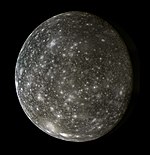Heimdall (Callistoan crater)
Appearance
 Map of Callisto based on Galileo and Voyager data. Heimdall is the bright spot at the bottom. | |
| Moon | Callisto |
|---|---|
| Coordinates | 63°30′S 3°00′E / 63.5°S 3°E[1] |
| Diameter | 210 kilometres (130 mi) |
| Eponym | Nordic god of light. |
Heimdall is one of the largest known impact craters on Jupiter's Galilean satellite Callisto, with a diameter of 210 km. It is located near the Callistonian south pole at 63°30′S 3°00′E / 63.5°S 3°E. It was firstly suspected on Voyager images, and later confirmed by Galileo.[2]
Cratered plains form the oldest recognizable unit on Callisto, but subtle differences in color and crater frequencies suggest regional differences in its development. The formation of Adlinda, Asgard, Valhalla, Heimdall, and Lofn crater appear to follow in that order.[3]
Heimdall was named after the god of light in Norse mythology; this name was approved by the International Astronomical Union in 2000.[4]
See also
References
- ^ "Heimdall (Callistoan crater)". Gazetteer of Planetary Nomenclature. USGS Astrogeology Research Program.
- ^ Bagenal, Fran; Dowling, Timothy E.; McKinnon, William B. (2007-03-05). Jupiter: The Planet, Satellites and Magnetosphere. Cambridge University Press. ISBN 978-0-521-03545-3.
- ^ Greeley, R.; Klemaszewski, J. E.; Wagner, R.; Team, Galileo Imaging (August 2000). "Galileo views of the geology of Callisto". P&SS. 48 (9): 829–853. doi:10.1016/S0032-0633(00)00050-7. ISSN 0032-0633.
- ^ "Planetary Names: Crater, craters: Heimdall on Callisto". planetarynames.wr.usgs.gov. Retrieved 2020-06-01.

